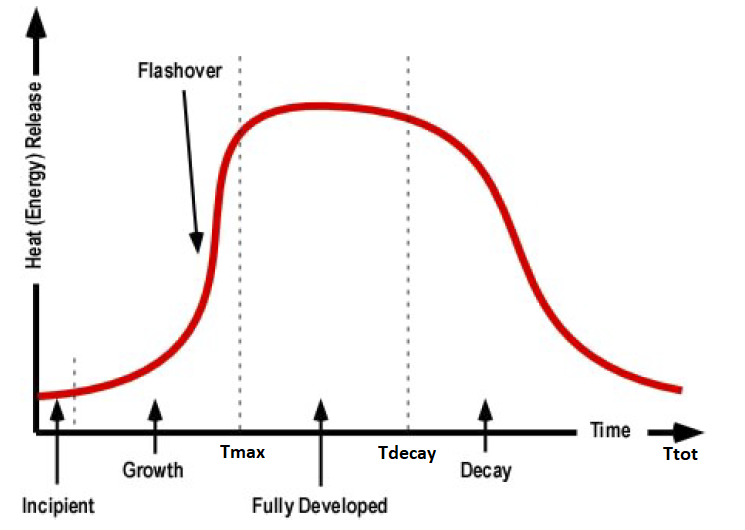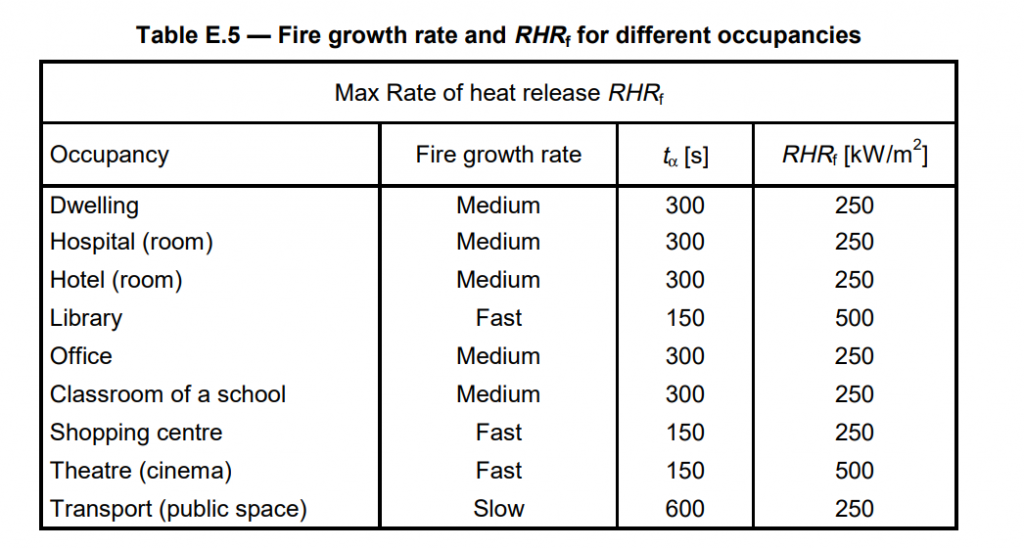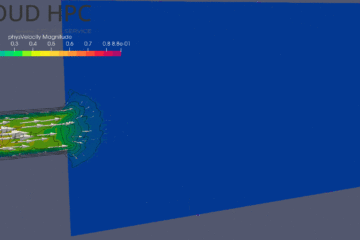A simplified way to assess the Heat Release Rate
The Heat Release Rate (HRR) is a fundamental parameter to describe the fire hazard. A simplified method to estimate HRR is analyzed in order to rapidly assess a fire hazard in FDS. Generally, in fire engineering, a the traditional fire development curve approximate the behavior of the HRR.
The Heat Release Rate (HRR) is the rate expressed in MW at which the combustion produces heat and the thermal power is released [1]. Its equations govern the amount of heat released within time and it assess the design fire size.
Only appropriate test are able to measure the actual heat release rate produced by the combustion of an item. In FDS the HRR can be simplified by means of the conventional fire development curve, which consider an overestimation of approximately 20% respect to the effective HRR [2].
Here it is exposed a simplified method to estimate the heat release rate and its traditional fire development curve, as indicated by the Italian Fire Code [3] and the Eurocode 1991-1-2 Appendix E [4].
The Heat Release Rate Conventional Curve
Generally, four stages describes the conventional Heat Release Rate curve: incipient, growth, stationary phase and decay. Flashover is a rapid increase in fire growth and consequently sudden transition to a fully developed fire. The times in which the fire development stages follow one another are:
- the time of initial growth (t0)
- the time in which the HRR is reaches its peak (tmax)
- time of initial decay (tdecay)
- the time to decay burnout (ttot).

A real fire don’t always follow the behavior described by the conventional fire development curve. In reality, the fire growth speed, peak heat release rate, and duration of burning depends on the type of fuel and the ventilation availability.
The following expressions are able to describe the typical stages of the fire development for fires where no suppression takes place.
Growth Stage
The following expression describes the growing phase:
HRR(t)= 1000 (t/tα)2 for t<tmax
where:
- HRR(t) is the heat release from the fire hazard
- t is time
- tα is the time needed to reach the heat release of 1000 KW
For instance, the Eurocode 1 UNI EN 1991-1-2 Appendix E define some values of tα for different occupancies, as shown by the following table E.5 [4]. Ultra-fast fires the value of tα is 75 seconds. For occupancies not included in the Appendix E or literature, the evaluation of tα depends on the expertise of the developer.

Stationary Phase
In the stationary phase of the fire hazard the HRR is steady and remains constant at its peak value till the decay phase starts.
HRR(t) = HRRmax for tmax<t<tdecay
The HRR maximum value depends on what governs the fire development. Fuel o ventilation can control the fire growth of a fire hazard.
Known the value of HRRmax, determine the time in which the stationary phase of the fire (tmax) starts as follow:
tmax = √(HRRmax ⋅ tα2 / 1000)
Fuel Controlled Fire
The fuel controlled fire depends on the amount of fuel available and the lack of oxygen limits its growth. Therefore, the fire growth only depends on the fire load area:
HRRmax=HRRf ⋅ Af
Where:
- HRRf is the thermal heat energy release per unite of gross floor area. Appendix E.4 of Eurocode 1 UNI EN 1991-1-2 shows some values of HHRf for different occupancies [kW/sqm];
- Af is the gross floor area of the compartment in case of uniform distribution of the fire load, or the floor area effectively occupied by the fire load [sqm].
Ventilation controlled fire
The ventilation controlled fire depends on the comburent availability, which can come through the ventilation openings and limits the fire growth. The following expression determine the HRRmax, for a ventilation controlled fire:
HRRmax = 0,10 ⋅ m ⋅ Hu ⋅ Av ⋅ √heq
Where:
- m is the combustion factor. The Italian fire code gives a value of m of 0,8 for wood and 1 for other combustible materials
- Hu is the calorific value of wood, equal to 17,5 MJ/kg
- Av is the opening area [sqm]
- heq is the equivalent height of the openings [m]
Decay
The fire’s stationary state ends at tdecay, time in which the decay starts and 70% of the initial thermal energy (qf x Af) is released, where qf is the fire load.
If the initial thermal energy is sufficient to overcome the propagation phase and reach the heat rate release maximum value:
70% ⋅ qf ⋅ Af ≥ 1/3 ⋅ 1000/ tα2 ⋅ tmax3
Therefore, calculate the time in which the stationary phase finish and the decay stars, as follow:
tdecay = tmax + ( 70% ⋅ qf ⋅ Af ≥ 1/3 ⋅ 1000/ tα2 ⋅ tmax3) / HRRmax
If the initial thermic energy is not sufficient to overcome the propagation phase, than the HRR curve will reach the peak and then directly starts to decay.
Consequently, The decay phase start at tdecay and will finish at ttot when the thermal energy released is null.
Ttot is calculated taking in consideration that the remaining 30% of the initially available thermal energy is consumed:
ttot = tdecay + (2 ⋅ 30% ⋅ qf ⋅ Af / HRRmax)
The following equation describes the HRR curve trend of the decay phase:
HRR(t) = HRRmax ⋅ (ttot – t) / (ttot – tdecay) for tdecay ≤ t ≤ ttot
For more information about the Cloud HPC and FDS, check the cloud hpc blog.
Bibliography
[1] Morgan J. Hurley, Editor-in-Chief, “SFPE Handbook of Fire Protection Engineering” 2015
[2] Andrea Dusso, Stefano Grimaza, Ernesto Salzanob, “Rapid Estimation of the Heat Release Rate of Combustible Items”, 2016
[3] D.M. 03/08/2015 and D.M. 14/04/2019, Italian Fire Code
[4] BS EN 1991-1-2:2002, “Eurocode 1:Actions on structures Part 1-2”, 2002
[5] Battalion Chief Ed Hartin, MS, EFO, MIFireE, CFO “Fire Development and Fire Behavior Indicators”
CloudHPC is a HPC provider to run engineering simulations on the cloud. CloudHPC provides from 1 to 224 vCPUs for each process in several configuration of HPC infrastructure - both multi-thread and multi-core. Current software ranges includes several CAE, CFD, FEA, FEM software among which OpenFOAM, FDS, Blender and several others.
New users benefit of a FREE trial of 300 vCPU/Hours to be used on the platform in order to test the platform, all each features and verify if it is suitable for their needs



0 Comments